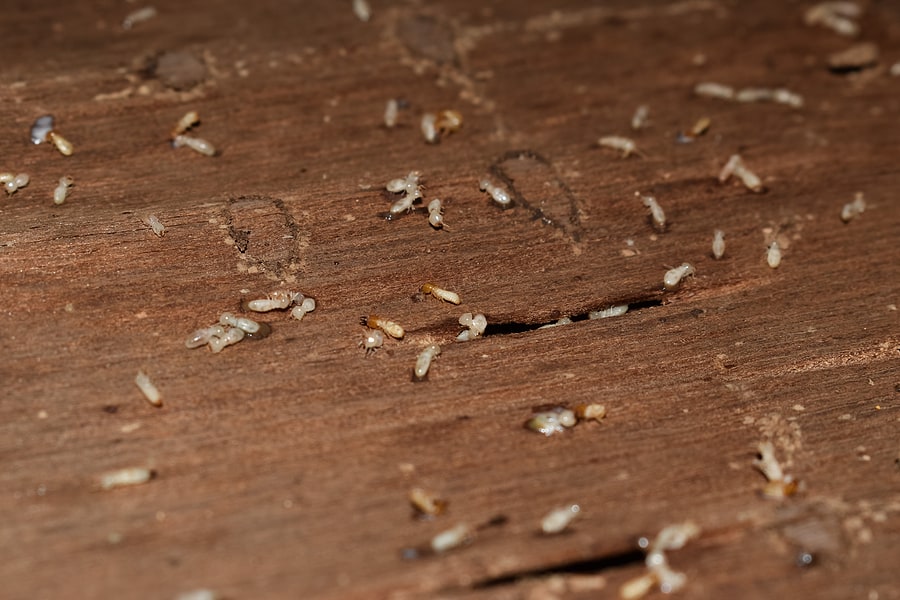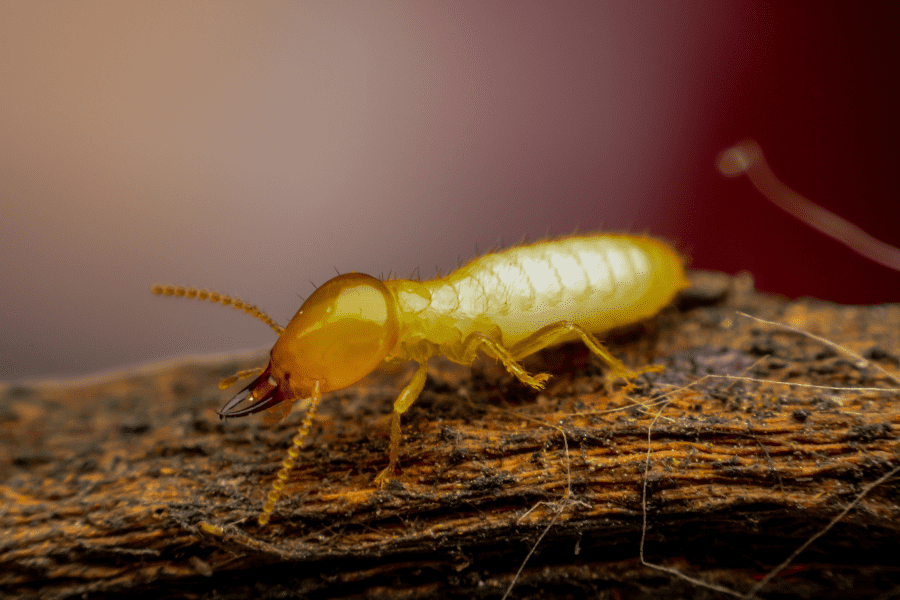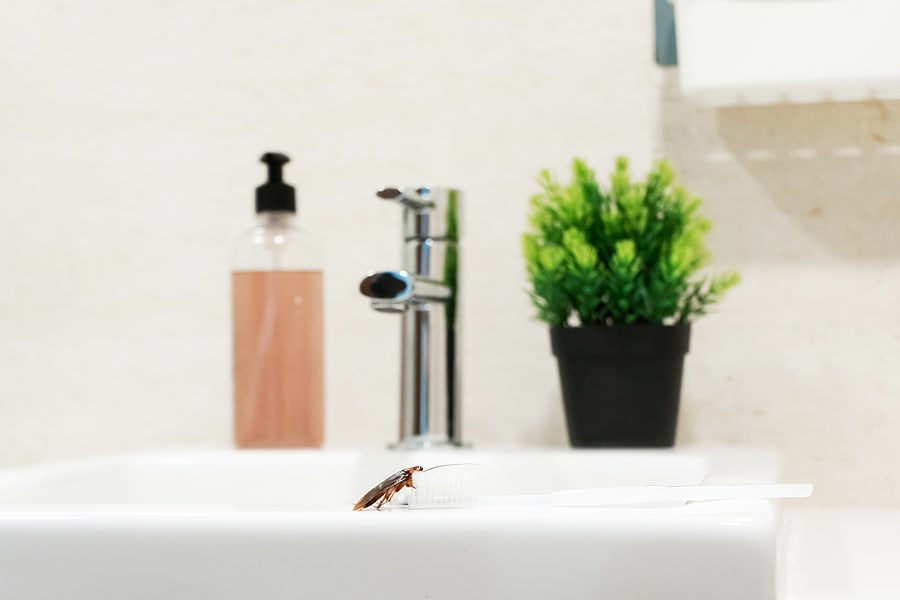READY TO GET STARTED?
REQUEST A FREE ESTIMATE
Fill out the form below or call (888) 466-7849 for a free, no-obligation estimate.

Termites will not stop until they find a food source for their colony, often destroying our homes in the process. A termite infestation can be devasting, as their damage can cost billions of dollars in repair. One of the best ways to avoid their damage is investing in termite control for your Alabama home. Let’s review the signs of termites and the several types of termite treatment options available so you can avoid their devastation.
Termites are silent destroyers, meaning they can go unnoticed for extended periods. However, there are many ways that you can tell you have a termite infestation.
When investing in termite treatment and prevention options, there are three common types of professional treatments that every homeowner should know, including bait stations, liquid-soil treatments, and wood treatments.
If you’re interested in these termite treatment options, consider contacting your local pest control company for more information. These professionals can provide you with a comprehensive inspection and help determine the best termite control plan for you and your home.

Discovering termites in your Tennessee home can be a concerning thought. Each year, termites cause billions of dollars’ worth of damage to homeowners. Don’t let your home fall under this statistic. We have all the information you need to begin termite prevention now.
Termites can’t level your home within a week or within five years, but over time they will eat away at your home from the inside out. They are difficult to spot and are incredibly quiet destroyers. The earliest signs of termite damage can be seen within months of them infiltrating your home.
One way to avoid property damage from termites is to have your home inspected once or twice a year. The best way to prevent termites is to have long-term termite control in place.
In the meantime, here are some DIY termite prevention methods you can do today:
Are you ready for long-term termite prevention in your Tennessee home? Give your local pest control company a call today and receive a free inspection to begin keeping termites away!

There are two factors to consider when looking at termite control: preventing them from infesting your home and treating established termite colonies. Termites are year-round pests and can go undetected for a long period of time, causing devastating damage in the process. There are several prevention methods to consider when looking to eliminate or prevent termites from your Laurens home.
One of the best and most effective ways to keep termites out is to remove any access inside your home, including gaps around water and gas lines where they enter your home. Likewise, inspect your foundation for cracks or openings and repair them immediately.
To survive, termites need wood and moisture. Eliminating these factors can help reduce your chance of a termite infestation. If you place mulch against your foundation for landscaping purposes, you could be attracting termites into your home. Mulch is a great source of food for termites as they retain any moisture. Try to minimize the use and keep it at least 15 inches away from the foundation. Additionally, if your crawlspace is experiencing a lack of airflow, it can create an ideal environment for these pests. Consider enclosing your crawlspace to prevent these termites and improve the overall health of your home by reducing moisture and decreasing humidity.
Termites can be tricky to control and eliminate! These pests will cause significant damage to your home, sometimes before you even realize they have infested. Placing preventative measures in your home to reduce the chance of a termite infestation will always help, but sometimes it’s best to leave it up to your local Laurens pest control company. These professionals can perform an annual termite inspection and provide you with the best termite control and prevention options for your home.

Spring is just around the corner and so are more pests! It’s the perfect time of year to begin prepping your home to keep spring pests away. Mosquitoes, termites, ants, and wildlife are common in the spring time, so it’s best to follow these tips to hopefully lessen your chances of a spring pest infestation.
Pests can fit through the tiniest of holes or cracks in your home. Be sure to examine your home for any potential openings in your foundation, windows, doors, and walls. You can use a silicone caulk to seal any discovered gaps.
Avoid leaving open food containers out in the open where it’s easy for pests to find. If possible, transfer open food containers to airtight containers that are plastic or glass. This will make it more difficult for some pests to chew through.
Mosquitoes and other spring pests utilize standing water to breed. It only takes the smallest amount of water to attract them to your home. Moisture is also an attractant for cockroaches, termites, and wildlife. Some ways to lessen moisture is to clean out bird baths and pet water bowls daily and check for any other objects, such as HVAC pans or old tires that can house an excess amount of water.
If you believe that your home has been taken over by any spring pests, be sure to reach out to your local Birmingham, Alabama pest control company to receive a plan of action today.
Spring brings warm weather and the need for spring cleaning. When making your spring to-do list, make sure to include pest control with it. The warm weather brings pests out in droves, whether emerging from their overwintering spots or searching for a mate to reproduce with. One of the most common spring pests are termites. Spring marks the beginning of termite swarming season, when termites leave their colonies in search of a mate to form a new colony with. Don’t forget to make termite treatment a priority on your spring checklist!
Termites can go undetected for long periods of time, causing significant damage to your home. Once you identify the signs of termites, the next step is to determine the best termite treatment for your situation. Here are some of the most common termite treatment options:
Pretreatments are termite treatments carried out during the construction phase of new construction. It is also preferable to use pretreatments when building additions to an existing home. When used before the physical infrastructure of a home or addition is laid, pretreatments are more effective and cost-effective. Pretreatments typically consist of a combination of liquid termiticide (often containing borates), termite bait, lumber treatment, and in-soil barriers.
Barrier treatments create a physical barrier between termites and your home. A trench is dug around your home’s perimeter, and the soil that is removed is heavily treated with a termiticide. The treated soil is then refilled into the trench. In some cases, a physical wall made of rock, sand, mesh, and plastic is built inside the trench’s outer wall. This adds another layer of defense between your home and termites.
The most common termite treatments are liquid treatments. These treatments are effective for termite infestations in your home’s interior. Holes are strategically drilled in both the foundation and the wood in these treatments. The termites are then forced to emerge after termiticide is injected into the holes. Termites are then exterminated using termiticide spot treatments.
Bait stations containing termiticide-laced wood, paper, or cellulose are placed in the ground around your home. Termites are drawn to the bait and consume it. The termiticide is slow acting, allowing termites to return to the colony and spread the bait to others, effectively killing the colony. Bait stations can be used in places where surface treatments cannot be used, such as near foundation drains and areas covered by slabs or flooring. Bait stations are a long-term and effective treatment solution.
While it can be tempting to attempt termite control yourself, it is usually best left to the professionals. If you have a termite infestation, contact your local pest control company for a termite inspection to determine the best treatment options for your home.
How to Manage Your Lawn & Prevent Lawn Diseases